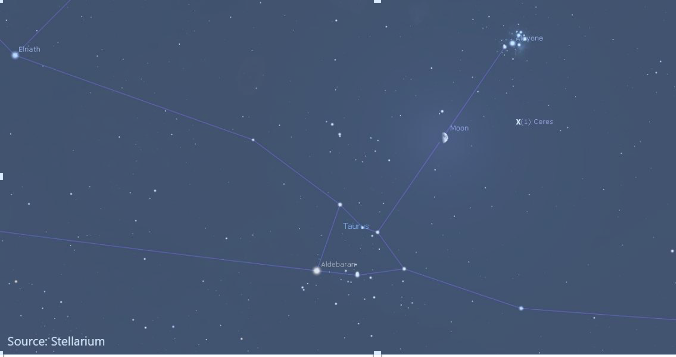2022 February 6
Observer’s Challenge: The Moon’s encounter with Ceres
On the 9th February just after 11:00UT the Moon occults (passes in front of) Dwarf Planet 1 Ceres which is the largest body in the asteroid belt between Mars and Jupiter. The occultation in full can only be observed from the Seychelles, with the path extending to Sri Lanka, parts of southern China and ending in Japan. By the time the Sun sets in the UK at 17:04UT, the Moon and Ceres are around 5 degrees apart midway between the Pleiades and the Hyades in Taurus at a respectable altitude of 58 degrees.
Ceres was discovered on 1st January 1801 by Giuseppe Piazzi but the first recorded lunar occultation of Ceres wasn’t until 1973 and then again in 2014. Neither of these events were visible from the UK.
On the 9th February, Ceres will be magnitude 8.5 at RA 03h 50m 16s, Dec +20 deg 16m 21s.
The Moon will be just past first quarter which was on the 8th February at 13:50UT, the Moon rises at 10:55UT and sets at 02:12UT.
The Sun will set at 17:04UT in the constellation of Capricorn.

The challenge is;
1/ Identify Ceres in a crowded star field.
2/ How soon after sunset can you observe Ceres?
3/ For imagers, can you get the Moon, Ceres and the Pleiades together in the same picture?
Depending on sky conditions it should be possible to pick Ceres up in a pair of binoculars. The apparent angular diameter will be 00.57 arc seconds, so essentially a pin point of light and at magnitude 8.5 below naked eye visibility. Identifying Ceres by observing the area over the preceding nights will show it move against the background stars. Below is the position of Ceres for the 5th-9th February.
5th Feb RA 03h 47m 35s Dec +19deg 54m 05s
6th Feb RA 03h 48m 06s Dec +19deg 58m 41s
7th Feb RA 03h 48m 39s Dec +20deg 03m 21s
8th Feb RA 03h 49m 14s Dec +20deg 08m 03s
9th Feb RA 03h 50m 16s Dec +20deg 16m 21s
Map generated in Stellarium
| The British Astronomical Association supports amateur astronomers around the UK and the rest of the world. Find out more about the BAA or join us. |
